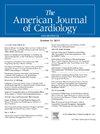National Costs for Cardiovascular-Related Hospitalizations and Inpatient Procedures in the United States, 2016 to 2021
IF 2.3
3区 医学
Q2 CARDIAC & CARDIOVASCULAR SYSTEMS
引用次数: 0
Abstract
The current economic burden of cardiovascular (CV)-related hospitalizations grouped by diagnoses and procedures in the United States has not been well characterized. The objective was to identify current trends in CV-related hospitalizations, procedural utilization, and health care costs using the most recent 6 years of hospitalization data. A retrospective analysis of discharge data from the National Inpatient Sample database was conducted to determine trends in CV-related hospitalizations, costs, and procedures for each year from 2016 to the most recent available dataset, 2021. Total CV-related costs were adjusted to and reported in 2023 dollars. In 2021, there were 4,687,370 CV-related hospitalizations at a cost of $108 billion. Heart failure hospitalizations accounted for the highest costs at $18.5 billion, followed by non-ST-elevation myocardial infarction at $11.2 billion and stroke at $10.9 billion. Significant upward trends in costs from 2016 to 2021 were observed for heart failure, stroke, atrial fibrillation, ST-elevation myocardial infarction, chest pain, hypertensive emergency, ventricular tachycardia, aortic dissection, sudden cardiac death, pericarditis, supraventricular tachycardia, and pulmonary heart disease. Over the 6 observational years, total costs increased by over $10 billion, representing a 10% increase. However, the increases were not linear, as there was a significant increase of 6.5% from 2018 to 2019, then a decrease of over 7% from 2019 to 2020, followed by an increase of approximately 6% from 2020 to 2021. By 2030, total CV-related costs are projected to reach $131.3 billion. For all years, coronary procedures were the most performed, followed by extracorporeal membrane oxygenation, non-bypass peripheral vascular surgery, pacemaker placement, and coronary artery bypass graft surgery. Both transcatheter aortic valve replacement and MitraClip procedures demonstrated significant upward trends from 2016 to 2021. Overall, from the years 2016 to 2021, CV-related hospitalizations, costs, and procedures demonstrated upward trends. In conclusion, CV disease remains a high burden in the hospital setting with tremendous health care costs.
2016-2021 年美国心血管相关住院和住院治疗的全国成本。
目前,美国心血管相关住院治疗的经济负担(按诊断和手术分组)还没有得到很好的描述。我们的目标是利用最近 6 年的住院数据,确定当前心血管相关住院、手术使用和医疗成本的趋势。我们对全国住院病人抽样(NIS)数据库中的出院数据进行了回顾性分析,以确定从2016年到最新可用数据集(2021年)每年心血管相关住院、费用和手术的趋势。与心血管相关的总费用已调整为 2023 年的美元,并以 2023 年的美元进行报告。2021 年,心血管相关住院人数为 4,687,370 人次,费用为 1,080 亿美元。心力衰竭住院费用最高,达 185 亿美元,其次是非 STEV 心肌梗死,为 112 亿美元,中风为 109 亿美元。从 2016 年到 2021 年,心力衰竭、中风、心房颤动、ST 段抬高型心肌梗死、胸痛、高血压急症、室性心动过速、主动脉夹层、心脏性猝死、心包炎、室上性心动过速和肺心病的费用呈显著上升趋势。在 6 个观察年中,总费用增加了 100 多亿美元,增幅为 10%。然而,增长并不是线性的,2018 年至 2019 年大幅增长 6.5%,2019 年至 2020 年下降超过 7%,2020 年至 2021 年又上升约 6%。到 2030 年,与冠心病相关的总费用预计将达到 1313 亿美元。在所有年份中,冠状动脉手术最多,其次是 ECMO、非旁路外周血管手术、起搏器安置和 CABG。从 2016 年到 2021 年,TAVR 和 MitraClip 手术均呈显著上升趋势。总体而言,从 2016 年到 2021 年,心血管相关住院、费用和手术均呈上升趋势。总之,心血管疾病仍然是医院的一个沉重负担,其医疗成本巨大。
本文章由计算机程序翻译,如有差异,请以英文原文为准。
求助全文
约1分钟内获得全文
求助全文
来源期刊

American Journal of Cardiology
医学-心血管系统
CiteScore
4.00
自引率
3.60%
发文量
698
审稿时长
33 days
期刊介绍:
Published 24 times a year, The American Journal of Cardiology® is an independent journal designed for cardiovascular disease specialists and internists with a subspecialty in cardiology throughout the world. AJC is an independent, scientific, peer-reviewed journal of original articles that focus on the practical, clinical approach to the diagnosis and treatment of cardiovascular disease. AJC has one of the fastest acceptance to publication times in Cardiology. Features report on systemic hypertension, methodology, drugs, pacing, arrhythmia, preventive cardiology, congestive heart failure, valvular heart disease, congenital heart disease, and cardiomyopathy. Also included are editorials, readers'' comments, and symposia.
 求助内容:
求助内容: 应助结果提醒方式:
应助结果提醒方式:


